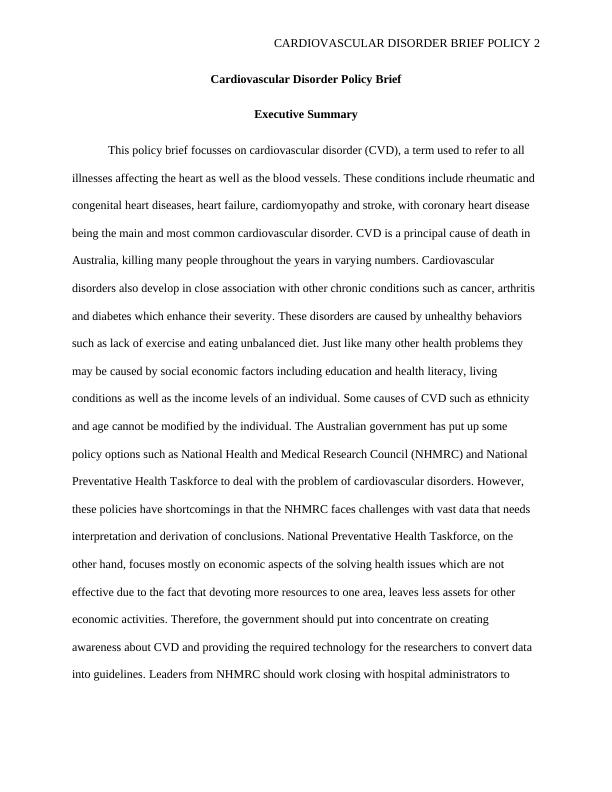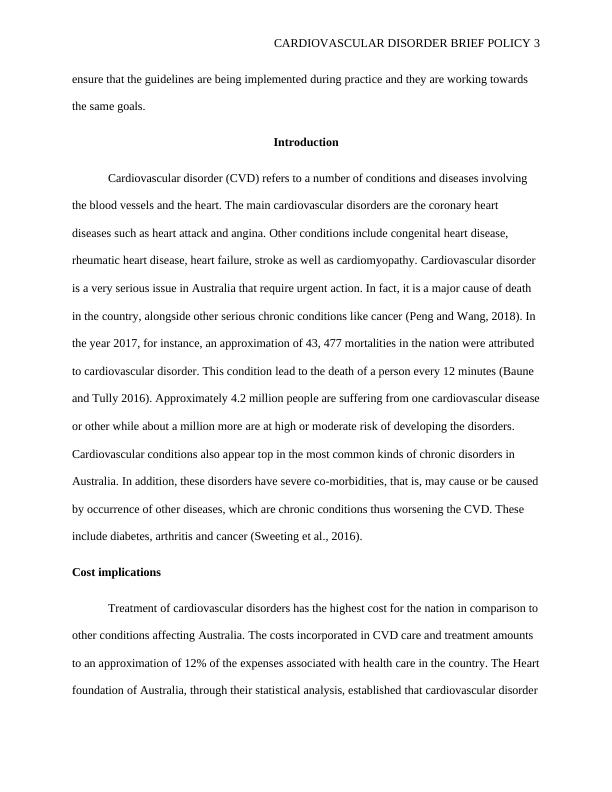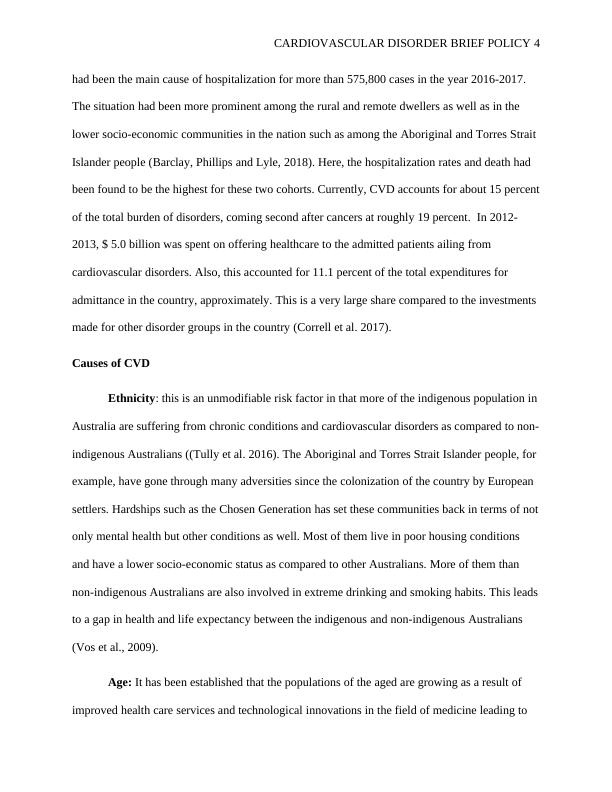Cardiovascular Disorder Policy Brief
Added on 2023-03-20
13 Pages3448 Words62 Views
CARDIOVASCULAR DISORDER BRIEF POLICY 1
CARDIOVASCULAR DISORDER POLICY BRIEF
Student’s Name
Subject
Lecturer
Institutional Affiliation
Due Date
CARDIOVASCULAR DISORDER POLICY BRIEF
Student’s Name
Subject
Lecturer
Institutional Affiliation
Due Date

CARDIOVASCULAR DISORDER BRIEF POLICY 2
Cardiovascular Disorder Policy Brief
Executive Summary
This policy brief focusses on cardiovascular disorder (CVD), a term used to refer to all
illnesses affecting the heart as well as the blood vessels. These conditions include rheumatic and
congenital heart diseases, heart failure, cardiomyopathy and stroke, with coronary heart disease
being the main and most common cardiovascular disorder. CVD is a principal cause of death in
Australia, killing many people throughout the years in varying numbers. Cardiovascular
disorders also develop in close association with other chronic conditions such as cancer, arthritis
and diabetes which enhance their severity. These disorders are caused by unhealthy behaviors
such as lack of exercise and eating unbalanced diet. Just like many other health problems they
may be caused by social economic factors including education and health literacy, living
conditions as well as the income levels of an individual. Some causes of CVD such as ethnicity
and age cannot be modified by the individual. The Australian government has put up some
policy options such as National Health and Medical Research Council (NHMRC) and National
Preventative Health Taskforce to deal with the problem of cardiovascular disorders. However,
these policies have shortcomings in that the NHMRC faces challenges with vast data that needs
interpretation and derivation of conclusions. National Preventative Health Taskforce, on the
other hand, focuses mostly on economic aspects of the solving health issues which are not
effective due to the fact that devoting more resources to one area, leaves less assets for other
economic activities. Therefore, the government should put into concentrate on creating
awareness about CVD and providing the required technology for the researchers to convert data
into guidelines. Leaders from NHMRC should work closing with hospital administrators to
Cardiovascular Disorder Policy Brief
Executive Summary
This policy brief focusses on cardiovascular disorder (CVD), a term used to refer to all
illnesses affecting the heart as well as the blood vessels. These conditions include rheumatic and
congenital heart diseases, heart failure, cardiomyopathy and stroke, with coronary heart disease
being the main and most common cardiovascular disorder. CVD is a principal cause of death in
Australia, killing many people throughout the years in varying numbers. Cardiovascular
disorders also develop in close association with other chronic conditions such as cancer, arthritis
and diabetes which enhance their severity. These disorders are caused by unhealthy behaviors
such as lack of exercise and eating unbalanced diet. Just like many other health problems they
may be caused by social economic factors including education and health literacy, living
conditions as well as the income levels of an individual. Some causes of CVD such as ethnicity
and age cannot be modified by the individual. The Australian government has put up some
policy options such as National Health and Medical Research Council (NHMRC) and National
Preventative Health Taskforce to deal with the problem of cardiovascular disorders. However,
these policies have shortcomings in that the NHMRC faces challenges with vast data that needs
interpretation and derivation of conclusions. National Preventative Health Taskforce, on the
other hand, focuses mostly on economic aspects of the solving health issues which are not
effective due to the fact that devoting more resources to one area, leaves less assets for other
economic activities. Therefore, the government should put into concentrate on creating
awareness about CVD and providing the required technology for the researchers to convert data
into guidelines. Leaders from NHMRC should work closing with hospital administrators to

CARDIOVASCULAR DISORDER BRIEF POLICY 3
ensure that the guidelines are being implemented during practice and they are working towards
the same goals.
Introduction
Cardiovascular disorder (CVD) refers to a number of conditions and diseases involving
the blood vessels and the heart. The main cardiovascular disorders are the coronary heart
diseases such as heart attack and angina. Other conditions include congenital heart disease,
rheumatic heart disease, heart failure, stroke as well as cardiomyopathy. Cardiovascular disorder
is a very serious issue in Australia that require urgent action. In fact, it is a major cause of death
in the country, alongside other serious chronic conditions like cancer (Peng and Wang, 2018). In
the year 2017, for instance, an approximation of 43, 477 mortalities in the nation were attributed
to cardiovascular disorder. This condition lead to the death of a person every 12 minutes (Baune
and Tully 2016). Approximately 4.2 million people are suffering from one cardiovascular disease
or other while about a million more are at high or moderate risk of developing the disorders.
Cardiovascular conditions also appear top in the most common kinds of chronic disorders in
Australia. In addition, these disorders have severe co-morbidities, that is, may cause or be caused
by occurrence of other diseases, which are chronic conditions thus worsening the CVD. These
include diabetes, arthritis and cancer (Sweeting et al., 2016).
Cost implications
Treatment of cardiovascular disorders has the highest cost for the nation in comparison to
other conditions affecting Australia. The costs incorporated in CVD care and treatment amounts
to an approximation of 12% of the expenses associated with health care in the country. The Heart
foundation of Australia, through their statistical analysis, established that cardiovascular disorder
ensure that the guidelines are being implemented during practice and they are working towards
the same goals.
Introduction
Cardiovascular disorder (CVD) refers to a number of conditions and diseases involving
the blood vessels and the heart. The main cardiovascular disorders are the coronary heart
diseases such as heart attack and angina. Other conditions include congenital heart disease,
rheumatic heart disease, heart failure, stroke as well as cardiomyopathy. Cardiovascular disorder
is a very serious issue in Australia that require urgent action. In fact, it is a major cause of death
in the country, alongside other serious chronic conditions like cancer (Peng and Wang, 2018). In
the year 2017, for instance, an approximation of 43, 477 mortalities in the nation were attributed
to cardiovascular disorder. This condition lead to the death of a person every 12 minutes (Baune
and Tully 2016). Approximately 4.2 million people are suffering from one cardiovascular disease
or other while about a million more are at high or moderate risk of developing the disorders.
Cardiovascular conditions also appear top in the most common kinds of chronic disorders in
Australia. In addition, these disorders have severe co-morbidities, that is, may cause or be caused
by occurrence of other diseases, which are chronic conditions thus worsening the CVD. These
include diabetes, arthritis and cancer (Sweeting et al., 2016).
Cost implications
Treatment of cardiovascular disorders has the highest cost for the nation in comparison to
other conditions affecting Australia. The costs incorporated in CVD care and treatment amounts
to an approximation of 12% of the expenses associated with health care in the country. The Heart
foundation of Australia, through their statistical analysis, established that cardiovascular disorder

CARDIOVASCULAR DISORDER BRIEF POLICY 4
had been the main cause of hospitalization for more than 575,800 cases in the year 2016-2017.
The situation had been more prominent among the rural and remote dwellers as well as in the
lower socio-economic communities in the nation such as among the Aboriginal and Torres Strait
Islander people (Barclay, Phillips and Lyle, 2018). Here, the hospitalization rates and death had
been found to be the highest for these two cohorts. Currently, CVD accounts for about 15 percent
of the total burden of disorders, coming second after cancers at roughly 19 percent. In 2012-
2013, $ 5.0 billion was spent on offering healthcare to the admitted patients ailing from
cardiovascular disorders. Also, this accounted for 11.1 percent of the total expenditures for
admittance in the country, approximately. This is a very large share compared to the investments
made for other disorder groups in the country (Correll et al. 2017).
Causes of CVD
Ethnicity: this is an unmodifiable risk factor in that more of the indigenous population in
Australia are suffering from chronic conditions and cardiovascular disorders as compared to non-
indigenous Australians ((Tully et al. 2016). The Aboriginal and Torres Strait Islander people, for
example, have gone through many adversities since the colonization of the country by European
settlers. Hardships such as the Chosen Generation has set these communities back in terms of not
only mental health but other conditions as well. Most of them live in poor housing conditions
and have a lower socio-economic status as compared to other Australians. More of them than
non-indigenous Australians are also involved in extreme drinking and smoking habits. This leads
to a gap in health and life expectancy between the indigenous and non-indigenous Australians
(Vos et al., 2009).
Age: It has been established that the populations of the aged are growing as a result of
improved health care services and technological innovations in the field of medicine leading to
had been the main cause of hospitalization for more than 575,800 cases in the year 2016-2017.
The situation had been more prominent among the rural and remote dwellers as well as in the
lower socio-economic communities in the nation such as among the Aboriginal and Torres Strait
Islander people (Barclay, Phillips and Lyle, 2018). Here, the hospitalization rates and death had
been found to be the highest for these two cohorts. Currently, CVD accounts for about 15 percent
of the total burden of disorders, coming second after cancers at roughly 19 percent. In 2012-
2013, $ 5.0 billion was spent on offering healthcare to the admitted patients ailing from
cardiovascular disorders. Also, this accounted for 11.1 percent of the total expenditures for
admittance in the country, approximately. This is a very large share compared to the investments
made for other disorder groups in the country (Correll et al. 2017).
Causes of CVD
Ethnicity: this is an unmodifiable risk factor in that more of the indigenous population in
Australia are suffering from chronic conditions and cardiovascular disorders as compared to non-
indigenous Australians ((Tully et al. 2016). The Aboriginal and Torres Strait Islander people, for
example, have gone through many adversities since the colonization of the country by European
settlers. Hardships such as the Chosen Generation has set these communities back in terms of not
only mental health but other conditions as well. Most of them live in poor housing conditions
and have a lower socio-economic status as compared to other Australians. More of them than
non-indigenous Australians are also involved in extreme drinking and smoking habits. This leads
to a gap in health and life expectancy between the indigenous and non-indigenous Australians
(Vos et al., 2009).
Age: It has been established that the populations of the aged are growing as a result of
improved health care services and technological innovations in the field of medicine leading to

End of preview
Want to access all the pages? Upload your documents or become a member.
Related Documents
Cardiovascular Disorders: Overviewlg...
|10
|2423
|83
Cardiovascular Disorder in Australialg...
|7
|1726
|83
Preventing Cardiovascular Disorders - Guidelines and Action Planslg...
|13
|3968
|71
Improving Cardiovascular Health in Australian Adults: A Policy Brieflg...
|12
|3079
|53
Upstreaming Approach to Nursing Care for Cardiovascular Diseaselg...
|2
|633
|70
Prevalence of Cardiovascular Diseases in Elderly People in Australialg...
|15
|3653
|295
